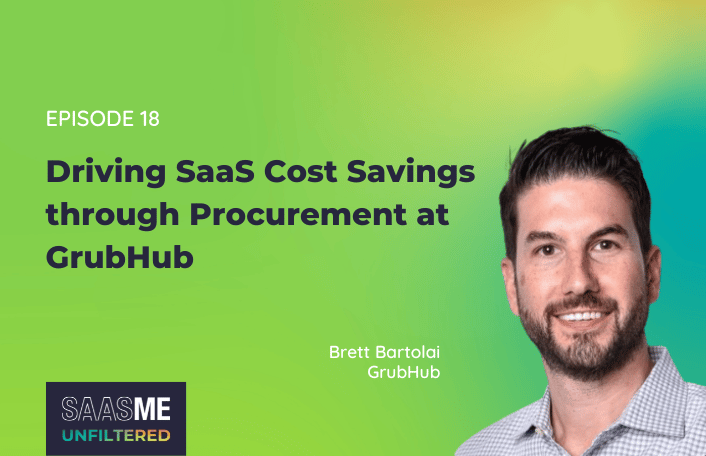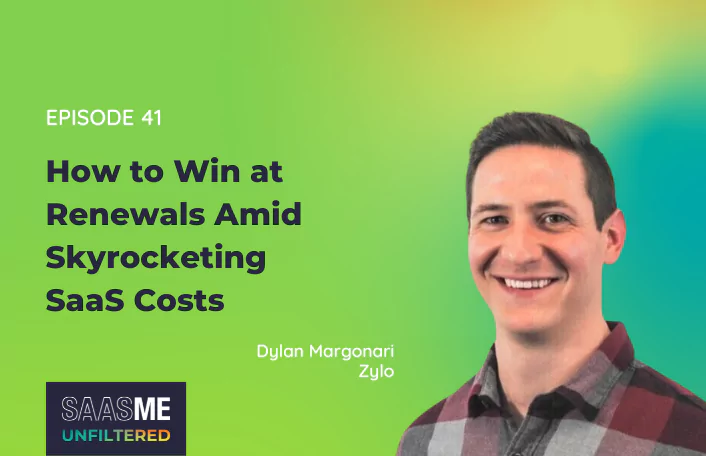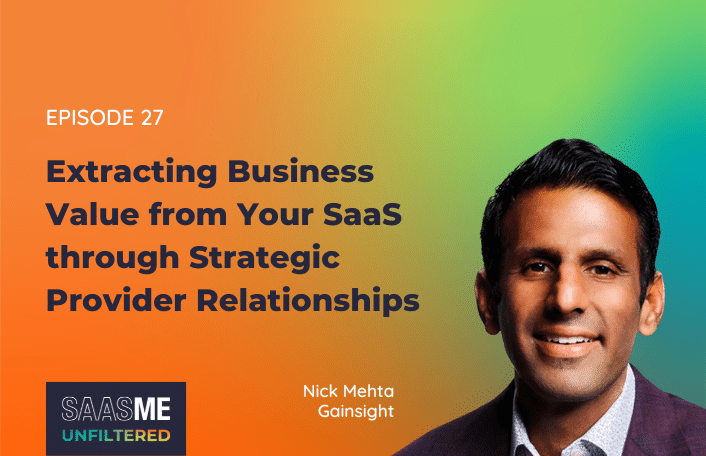
Brett Bartolai: Driving SaaS Cost Savings through Procurement at GrubHub
Table of Contents ToggleEpisode SummaryGuest SpotlightEpisode HighlightsProcurement Plays an Integral Role...
Back
Back
Search for Keywords...
Blog

10/19/2023
Table of Contents
SaaS suppliers are increasing prices at mind-boggling percentages on a spend category that’s already through the roof. That makes getting a favorable renewal feel like a losing scenario. But according to procurement pro and SaaS negotiator Dylan Margonari, there are ways to find a win. In this episode, Margonari delves into how to prepare for your upcoming renewals, the big gotchas in SaaS contracts, and tactics to mitigate the one-two punch of those steep price increases.
Procurement pro Dylan Margonari understands the frustration of SaaS renewals and negotiating in a market where suppliers are skyrocketing SaaS prices.
In this episode, he examines a few common “gotchas” lurking in SaaS contracts, helping you navigate the fine print and avoid costly surprises.
“Auto-renewals can be a trap sometimes,” said Margonari, “especially if you don’t have visibility into your SaaS portfolio.”
But it’s not all doom and gloom! Margonari also offers practical tips for working with your partners to negotiate a better deal.
“Being transparent with vendors is a great starting point for any negotiation, especially in the economic climate that we’re in today,” he added.
If you’re tired of feeling like a victim of rising SaaS costs, tune in to this episode. Margonari’s expertise will empower you to take control of your negotiations, protect your business, and drive better outcomes.
Get ready to turn the tables on those price increases and secure a deal that works in your favor!
Name: Dylan Margonari
What he does: SaaS Services Manager at Zylo
Connect with Dylan online: LinkedIn
“Everyone is a buyer of SaaS. If you have a credit card, you can go online, view a product, punch in those numbers, and boom, your tool’s there up and running, and you’re ready to use it. So that’s the most challenging part is it can sprawl out of control at a drop of the hat. If everyone has a credit card, they’re spending it. So I think it’s three different areas that make it challenging. So inventory, or visibility, really understanding what does that portfolio look like? Do we have a policy? Who’s monitoring this? Who’s reviewing this before we’re purchasing?
Bandwidth is probably the second piece that makes it challenging is not every organization has a dedicated procurement resource or team. So, oftentimes, we see it land on the department manager’s desk to negotiate and monitor those agreements, user accounts. Obviously, they’re managing other things. They don’t have the time in the day to monitor every piece of software that they are utilizing in their department.
And then the third factor is the market. It’s ever changing. We’ve seen in the last year, no one has a crystal ball. You don’t know what’s going to happen year to year. With the market changing, obviously, that changes negotiation tactics. It changes how vendors are portraying their tool, selling their tool, things of that nature. And those three things are definitely the three that stick out in my mind that make this the most challenging thing to manage and monitor on a daily basis.”
The Ultimate Guide for Wildly Effective SaaS Renewals
Learn More“Data, it’s a gold mine in the procurement world. If you don’t have it, for the lack of better way of saying it, you’re shooting from the hip. May as well just throw it up on a dartboard, throw a dart, see what sticks, and that’s the price you’re targeting in your negotiation. And, quite frankly, I’ve been in that position in my experience, before I came to Zylo. I didn’t have all those data points at my fingertips. Now, I do. And, again, it’s a huge goldmine for us. We’re going into every negotiation prepared. We have the utilization metrics, whether it’s head count, user count, or data usage, what are you consuming in some of those types of agreements. And then, also, I think something that may get overlooked if you don’t have the full portfolio, or the full visibility in everything you’re buying, is what apps are overlapping? Meaning, what apps have the same exact functionality? … Each department’s using their own tool. There’s no efficiencies there.
So having that data point. And then taking it to the stakeholders and the executives, and just sharing that insight with them. And saying, ‘Hey, what’s the preferred tool here? Does it make sense to have 12? If so, great.’ But, in more cases than not, let’s try to trim that down. Let’s really look at this holistically. And try to bring in some efficiencies to our business, where our tools, our departments are talking to each other. We’re making that SaaS software stack as lean as possible. And then, the best for last, is pricing insights. When you have that at your fingertips, you’re able to go to the vendor. And you have visibility into that market price. You know if you’re getting something at a good rate. And if you’re not, you’re able to share that insight with them and your stakeholders.”
“Data, it’s a gold mine in the procurement world. If you don’t have it, you’re shooting from the hip.”
“I’ll start with, any new purchase, probably goes into any renewal as well, but it goes beyond price. A lot of the time in the procurement realm, your focus can lean price first and price everything. Not the case. It’s not a one and done here. You’re going to have this partnership for probably many years, so relationship is key. When you’re looking at a new purchase, understanding, what is that right user count? And then adding a little bit of buffer into that user count to ensure your needs are met throughout that contract. And you’re not getting hit with extremely overpriced overage overcharges that we see from all of our SaaS solutions there. To broaden that topic is an expansion rate table. So you’re not going to hit the user count right on the head every single time. So negotiating an expansion table for any add-on users throughout that term… building some sort of table that you don’t have to renegotiate. You don’t have to reinvent the wheel every single time you have a headcount increase, or you bring on a new individual to the company or department.
And then, price cap… Getting a price cap that says, ‘3% to 5% increase upon renewal,’ that’s fair. It’s going to reduce the time of that renewal cycle. And, again, you’re not going to have to reinvent the wheel every time you’re signing a new contract with your vendors. And then, the last point, another gotcha to look out for, is auto-renew clauses. This can be a trap sometimes, especially if you don’t have the visibility into your SaaS portfolio. But auto-renewals, they’re just going to continue to auto-renew, send you invoices every time the contract expires. So making sure that language is not in the agreement allows you to cancel applications when you need to cancel them. Those are some of the gotchas and, quite frankly, every renewal, or every time you’re purchasing SaaS, those four things I would definitely look to build into your contract.”
“A lot of the time in the procurement realm, your focus can lean price first and price everything. Not the case. It’s not one and done here.”
The noise is loud right now, and it’s ever changing. And to address the elephant in the room, SaaS is increasing in price. So everywhere, no matter what it is, you are seeing price increases. And, in fact, since I’ve been in this role, if 5% to 7% was common, now we’re seeing upwards of 15%, even higher than that, across the board, within the tech industry. It’s hamstringing a lot of our customers. What do you do? You need the products, and the market is just pushing price, and applying more and more pressures to our customers, just within the market in general. So, obviously, prices are increasing across the board. But we’re also seeing the factors of our customers are reducing budget. They’re reducing headcounts, which impacts the renewal and the leverage that any procurement professional has during a negotiation, which makes it a little bit tougher. You’re renewing a lower headcount. You can suspect that that rate will increase per user. So it’s definitely challenging. So, oftentimes, in an economy like today, a flat renewal is still a win. I want to highlight that. Keeping a flat year-over-year price is something that I push for when we are reducing headcounts, like we see it. And the specific customer story that I really want to dive into, it’s quite scary, and definitely goes right within this topic of headcount reduction, downsizing license counts. And we’re seeing price just skyrocket. So for this example, 1,000 users purchased last year, we were reduced to 500 users. And, somehow, that order form comes back at the exact same cost. You cut 500 users from your agreement.”
“Partnership is huge. And being transparent with those vendors is a great starting point for any negotiation, especially in the economic climate that we’re in today. A couple of areas to key in on are, fiscal year ends, quarter ends, a lot of the times the sales reps… Well, we know that they have quotas to meet. And so they’re pushing for those end dates. Using that to your leverage to get to a preferred result, whether it be signing an agreement early for a flat renewal, or increased incentive, increased discounting, using that to your leverage and pushing for that, and coming to a win- win scenario with a vendor at the end of the day. Also, knowing is your provider publicly traded or private? Because publicly traded companies, as we all know, they’re reporting their revenue on a quarterly, annually basis. So they have additional targets to meet. And, oftentimes, that can be challenging in a negotiation if, let’s say, they’ve had a tricky quarter.”
“Being transparent with vendors is a great starting point for any negotiation, especially in the economic climate that we’re in today.”
“New pricing models, this is a newer thing, specifically in the data housing space. I think it’s a trend that’s picking up steam, where some of these data housing vendors traditionally just charged per user. Now, they’re adding, on top of the per user rate, they’re adding an additional consumption rate to it. Again, this is another scenario where contracts are not changing. We’re purchasing the same thing. But we’re just adding another layer to that contract, more money in the vendor’s pocket for this same verbatim service that has been going on for the previous contract year. And to put that in perspective for you, with these consumption fees being added to contracts, I’m seeing it in the neighborhood between 25% and 50% increases on top of the user rates that have already been paid. It’s another mouth hit the floor moment for our relationship owners. And another layer to that is, not only are they adding these fees to the contracts, they’re letting us know 60 days in advance of a renewal. You both own some tools. Your owners’ software licensing agreements within your organizations, tell me, does 60 days give you enough time to digest a 25%, 50% increase and prepare for that?”
“There’s so many options out there, so how do you choose? My advice is look for someone that is a partner you’re going to be able to build a relationship with built on credibility, expertise. Someone that you can just trust that is going to put your organization’s needs first. I can’t stress that enough. So what you’re looking for is, basically, someone to be a member of your team. Not just an outsourced team or individual that, ‘Hey, they’re just negotiating a contract based on price, beating up vendors.’ You need a more partnership approach. Oftentimes, I think a big mistake, just finding a more or less black box approach, where you’re sending a renewal request to an alias, where there’s a team of individuals behind that alias. And it gets assigned to anyone. It’s not a consistent person that you’re working on renewals and SaaS management on a daily basis. Someone that you may not know. You may not have the trusted credibility or expertise. This may be the first time you’re meeting the individual and they’re renewing a product on your behalf. So I can’t stress enough: partner like, consistent, dedicated resource, that has the best interest for your organization.”
5:08 – “The most challenging part is it can sprawl out of control at the drop of a hat.”
6:53 – “Data, it’s a gold mine in the procurement world. If you don’t have it, you’re shooting from the hip.”
12:14 – “A lot of the time in the procurement realm, your focus can lean price first and price everything. Not the case. It’s not one and done here.”
21:21 – “You’re renewing a lower headcount. You can suspect that that rate will increase per user.”
24:10 – “Being transparent with vendors is a great starting point for any negotiation, especially in the economic climate that we’re in today.”
32:31 – “Does 60 days give you enough time to digest a 25%, 50% increase and prepare for that?”
Check out other episodes here, Apple Podcasts, Spotify, or wherever you listen to podcasts.
ABOUT THE AUTHOR

Cory Wheeler
As Zylo’s Chief Customer Officer, Cory is responsible for helping our customers drive ROI and SaaS Management success with Zylo. He helps companies of all sizes effectively discover, optimize, and govern their SaaS through Zylo’s platform and services. Prior to founding Zylo, Cory spent 15 years in finance and procurement, managing categories and sourcing teams at Arthur Andersen, BearingPoint, and both Takeda and Astellas Pharmaceuticals. He built the procurement organization at ExactTarget, and managed the integration with the Salesforce Marketing Cloud procurement organization in 2015. He and his family reside in Indianapolis, IN, where they can be found cheering for the Purdue Boilermakers and Chicago Cubs.

Table of Contents ToggleEpisode SummaryGuest SpotlightEpisode HighlightsProcurement Plays an Integral Role...

Cut Software, Not Jobs SaaS is critical to your business, yet...

Table of Contents ToggleEpisode SummaryGuest SpotlightEpisode HighlightsValue Is about More Than...
| Cookie | Duration | Description |
|---|---|---|
| cookielawinfo-checkbox-analytics | 11 months | This cookie is set by GDPR Cookie Consent plugin. The cookie is used to store the user consent for the cookies in the category "Analytics". |
| cookielawinfo-checkbox-functional | 11 months | The cookie is set by GDPR cookie consent to record the user consent for the cookies in the category "Functional". |
| cookielawinfo-checkbox-necessary | 11 months | This cookie is set by GDPR Cookie Consent plugin. The cookies is used to store the user consent for the cookies in the category "Necessary". |
| cookielawinfo-checkbox-others | 11 months | This cookie is set by GDPR Cookie Consent plugin. The cookie is used to store the user consent for the cookies in the category "Other. |
| cookielawinfo-checkbox-performance | 11 months | This cookie is set by GDPR Cookie Consent plugin. The cookie is used to store the user consent for the cookies in the category "Performance". |
| viewed_cookie_policy | 11 months | The cookie is set by the GDPR Cookie Consent plugin and is used to store whether or not user has consented to the use of cookies. It does not store any personal data. |
